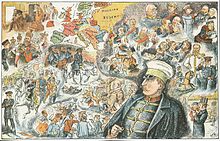Henry du Pré Labouchère
Henry du Pré Labouchère (born November 9, 1831 in London , † January 15, 1912 in Florence ) was a British politician.
Life
Labouchère was born in London into a Huguenot family. He had two younger brothers and six sisters. His father was a banker and enabled him to attend Eton College and Trinity College (Cambridge) . After graduating from school, he joined the diplomatic service through the mediation of the family. From 1854 to 1864 he worked in the embassies of Washington , Munich , Stockholm , Frankfurt am Main , St. Petersburg , Dresden and Constantinople . In 1865 he was elected Liberal Member of Parliament for the County of Windsor. In 1867 he joined Middlesex and took part in a theater project. In 1868 he was defeated by the Conservative candidate. This started 12 years of extra-parliamentary activity for him.
After John Forster resigned as editor of the Daily News , which was founded by Charles Dickens in 1846 , he played a key role in the further development of this newspaper from 1870 onwards. In the same year the pacifist London daily Morning Star was taken over by the Daily News . 1870-71 he published the diary of a besieged in Paris in the Daily News , which later appeared as a book (German, Leipzig 1871).
From 1868 he lived with the actress Henrietta Hodson, who was still married. Labouchère relied on the talent of Hodson and promoted them. The theater was not a success and had to close in 1879. In 1884 their daughter Mary Dorothea was born. The couple only married in 1887 after Hodson's husband died.
From 1880 he was together with Charles Bradlaugh Member of Parliament for Northampton . Both were considered liberal.
Labouchère has also distinguished himself for his lively participation in the Irish obstructionist efforts in the House of Commons. He also supported William Ewart Gladstone .
A popular roulette game system bears his name, see Labouchère .
He was related to Henry de Labouchère, Lord Taunton .
Truth weekly
In 1876 Labouchère founded the satirical weekly Truth (German: Truth) to compete with a paper called The World (German: Die Welt), which he had previously left. The first edition of Truth appeared on January 4, 1877. Labouchère was perceived by the public as an opponent of women's suffrage and in some cases as an anti-Semite . There were some legal battles over the scandals he exposed. One of his main opponents was the newspaper publisher Edward Levy-Lawson , editor of The Daily Telegraph, founded in 1855 . In 1890 the magazine Truth caused an international stir with a fictional interview that the editor conducted with a professor of hypnosis. It describes the dream of the German emperor ("The Kaiser's Dream"), in which - according to the interpretation - the downfall of the European monarchies through a great war is predicted. This is interpreted by conspiracy theorists in such a way that Labouchère wanted to reveal his knowledge of secret plans for the First World War with this publication . The magazine also published a color map of Europe depicting the doom scenario. However, a German translation did not appear until 1927. At that time, Truth had a circulation of one million. The last edition appeared in 1957.
literature
- Eckardstein, Hermann, Freiherr von: Memoirs and political memorabilia , P. List, Leipzig 1919.
Individual evidence
- ↑ http://www.labouchere.co.uk/linkpages/labbyanddora.htm
- ↑ a b " Truth Closes Down". The Times . December 31, 1957, page 6
- ↑ Hirshfield, Claire. "Labouchere, Truth and the Uses of Antisemitism", Victorian Periodicals Review , Vol. 26, no. 3 (Fall 1993), pp. 134-142
- ↑ Eugen Lennhoff, Oskar Posner: Internationales Freemaurerlexikon. 1932, under the heading Bodung-Verlag
| personal data | |
|---|---|
| SURNAME | Labouchère, Henry du Pré |
| BRIEF DESCRIPTION | British politician |
| DATE OF BIRTH | November 9, 1831 |
| PLACE OF BIRTH | London |
| DATE OF DEATH | January 15, 1912 |
| Place of death | Florence |

